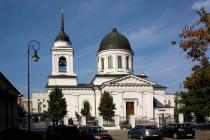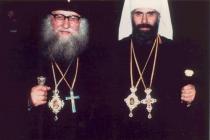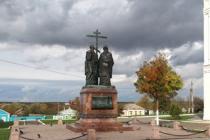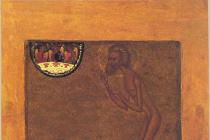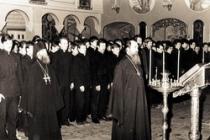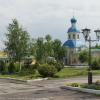It is a well-known fact that the majority of Poles are representatives of the Catholic Church. In the countries of the former Soviet Union you can often hear the following question: “is he Orthodox or Polish”? Perhaps due to the fact that Poland is a neighboring state and our history is closely intertwined, we associate it with Catholicism, completely forgetting about many other Catholic countries.
Today, to prove that many people of the Orthodox faith live on the territory of the Republic of Poland, we will talk about some churches that are popular among parishioners.
Cathedral of St. Nicholas the Wonderworker in Bialystok

It is the Podlaskie Voivodeship that is famous for the fact that half of the population is representatives of the Orthodox Church. Orthodox holidays are revered here, and winter holidays in educational institutions and government agencies do not end in early January, but continue until 9.
One of the most beautiful and famous churches in Bialystok is located at Lipowa 15. The majestic Cathedral of St. Nicholas the Wonderworker was built in 1843-1846, the design of which was drawn up in St. Petersburg in the Commission of Projects and Estimates. The new church was consecrated by a famous church figure, Archbishop of Lithuania and Vilna Joseph (Semashko), a fighter against the union. In 1910, during the renovation of the temple, the artist Mikhail Avilov painted the interiors in the Vasnetsov style (the image of the Risen Savior on the High Place was preserved).
St. Nicholas Cathedral is a good example of late classicism. Above its main volume, a massive helmet-shaped dome rises on a high light drum. Above the entrance is a single-tier bell tower. The architectural design is modest. The temple is painted white, gilded and decorated with rich carvings. The icons of the royal gates were painted in 1844 by the artist Malakhov.
The main shrine of the temple is the incorruptible relics of the infant martyr Gabriel of Bialystok (Zabludovsky), transferred on September 22, 1992 from the Cathedral of Grodno in Belarus.
Spaso-Preobrazhensky Cathedral in Lublin

The temple was built in 1607-1633. on the site of two earlier churches. The construction of the cathedral dragged on for 26 long years, the reason for which was the religious conflicts that reigned in Lublin at that time. However, in 1633, Władysław IV Vasa became the king of Poland, who confirmed the right of the Orthodox community to own the church in Lublin. The king helped the community by granting a number of important privileges, including excluding the church from the jurisdiction of the Uniates.
But still, in 1695 the temple again came under the control of the Uniates. The Lublin parish returned to the Orthodox Church only in 1875, after the liquidation of the Kholm Uniate Archdiocese.
The Transfiguration Cathedral is the main one in the Lublin-Holm diocese of the Polish Autocephalous Orthodox Church and the seat of the Transfiguration deanery of Lublin. Located on ul. Ruskiej.
During the First World War, all valuable icons were taken from the church to Moscow, which never returned to Lublin. After the restoration of Polish independence, they wanted to close the cathedral, but nevertheless abandoned this idea.
It is surprising that throughout its difficult history, the temple is still open and popular among parishioners. An important fact: in February 1960, the Transfiguration Cathedral was included in the register of monuments of Poland.
Orthodox Church of Faith, Hope, Love and their mother Sophia in Sosnowiec

The temple is located in Sosnowiec, on Jana Kilińskiego street 39, next to the Warsaw-Vienna line railway station. It is the administrative center of one of two Orthodox parishes covering the territory of the current Silesian Voivodeship.
The church was erected in a fairly short period of time. August 15, 1888 The first stone was laid, and on November 28, 1889 the church was consecrated by Bishop Flavian of Ljubljana.
The temple was built of brick, in the Byzantine style. Consists of five parts. The central part is covered with a lovely dome. Inside there is a delightful, more than century-old iconostasis.
By the way, the church has its own website, where you can find out in more detail the history of the temple, the calendar of Orthodox holidays, and also see the date and time of services.
Contrary to stereotypes, Poland is still not a completely Catholic state. Today, there are 6 Orthodox dioceses in Poland with 11 bishops, 27 deans, 250 parishes and 10 monasteries. The Polish Orthodox Church is headed by Metropolitan Sawa (Grycuniak) of Warsaw.
If you are planning a trip to Poland soon, or even moving altogether, don’t worry. Here, just like at home, you can go to church on weekends and religious holidays.
Post-war Poland is probably the most nationally and religiously homogeneous country: almost all its citizens are Poles by nationality and Catholics by religion. For many centuries until the very middle of the twentieth century, this was not the case: Poland was, rather, a multinational empire. While Ukraine strives to join the European Union, few people know that Ukrainians and Belarusians already live in the EU. We are not talking about emigrants, but about Polish Ukrainians and Belarusians - the last remnants of the former multinational Poland. Some of them are even involved in politics. Slon.ru offers an interview with the only Orthodox deputy of the Polish Sejm - deputy chairman of the parliamentary commission on issues of national and ethnic minorities, editor-in-chief of the Polish magazine "Orthodox Review" ("").
- Gospone Chiquin, pan Chiquin, what is the best way to address you?
Well, because this is an interview for a Russian online publication, let’s go ahead, Evgeniy Grigorievich. It will be better this way.
Evgeny Grigorievich, where did the Orthodox come from in Catholic Poland? Poland is traditionally considered a stronghold of Catholicism, isn't it?
Within its current borders, Poland is an exclusively homogeneous state in terms of nationality and religion; it is a mononational country. Moreover, about 90% of the population declare that they belong to the Roman Catholic Church.
In 2002, for the first time since World War II, Poland's census asked about nationality. And it turned out that all national minorities in Poland make up about one percent! If you multiply this figure by 3-4 - many did not want to declare non-Polish nationality due to the specifics of living in their area, often these are single people - even a theoretical 3-4% gives a very homogeneous picture.
Orthodoxy has existed in what is now Poland since the mission of Saints Cyril and Methodius. Orthodoxy came to us from Kievan Rus in the 11th century; I am now talking about the territory of the Podlasie Voivodeship of Poland, where Orthodox Christians historically live compactly. Then Orthodox monks came here, preaching Christianity and converting local residents to Orthodoxy.
Of course, now there are Orthodox parishes throughout Poland. Orthodox Christians also live in the west of the country: after the war, during the Vistula action, Ukrainians were forcibly resettled to former German lands, defining themselves as a separate ethnic group of Lemko-Rusyns.
-How many Orthodox Christians are there in Poland now?
The Polish Autocephalous Orthodox Church is believed to have about half a million believers. But in reality, I believe, it is 300,000 - 400,000 per 38 million population. By the way, my ancestors, in particular my father, never called themselves Belarusians, although we live on the border with present-day Belarus. But when asked what your nationality is, my father answered: “Orthodox.”
This was the specificity of the border, the boundary: here such a special situation has developed over centuries, the border of Western and Eastern Christianity, the border of Western Latin and Byzantine-Russian civilization. It was a centuries-long struggle to preserve one’s identity, both national and religious. All this has developed unique protective mechanisms. Therefore, for my father, the main thing was the broad concept of “Orthodoxy.” And if someone “pressed” my father: after all, what is your nationality, he always answered: “Russian,” meaning the concept of “Russianness” since the times of the Grand Duchy of Lithuania.
After the signing of the Union of Lublin, when the Grand Duchy of Lithuania united with the Polish-Lithuanian Commonwealth, then on the territory of this common state there were more Orthodox Christians than Catholics! Because the vast lands that were included in the new formation, present-day Belarus, Ukraine - these were all Orthodox people. Then they were called “Russian people of the old Greek faith.”
-And when they ask you, what is your nationality?
I consider myself an Eastern Slav. Everything that my father had is very close to me. According to documents, I am Belarusian, because this culture and this tradition are closest to me. But Russian and Ukrainian culture are just as close to me. In my village, at weddings, parties, and christenings, Belarusian, Russian and Ukrainian songs were always sung. And they were all accepted as “ours.” The main thing was the definition that “we are not Poles.”
-In the territory where Orthodox Christians live compactly,- Bialystok area, Gainovka, near Belovezhskaya Pushcha,- state borders have moved several times over the last century. From 1939 to 1941, Bialystok was even part of the USSR. How did people live in such conditions?
My father was born in the Russian Empire in 1914. And during his life, the borders changed nine times! This is for one human life! Of course, all this had to be combined with loyalty to the state, some left, other authorities came... But, despite all the difficulties, our people have always been very attached to their faith and their ethnic self-determination, to the “Russianness” about which I told. We are a kind of phenomenon, for so many centuries of pressure from Western civilization, the Roman Catholic Church, we have preserved our identity both in the religious sense and in the national sense.
- National identity in Bialystok - what is it like now?
Today these processes are very dynamic. Young people more often call themselves Belarusians in this part of Poland, in the border areas with Belarus. Some residents consider themselves Ukrainians. Another part, unfortunately, more and more often call themselves Orthodox Poles.
Poles are always offended by Russia and consider themselves victims of Russia and its imperial ambitions. So, in any case, say many leading Polish politicians who now lead the country. Is this a “victim” complex?
The problem of “victim” in Polish self-awareness is the result of a kind of messianic romanticism: when Poland did not exist as a state on the map of Europe and was divided between Russia, Austria and Prussia, then the Poles dreamed of recreating statehood and messianic thinking took over their minds. We are a victim, we Poles have a specific mission, we are the line between the barbaric East and the civilized West.
Now this is taking strange and outlandish forms due to some Polish politicians who want to reinterpret history. This is called "historical politics". They are trying to convince Poles, for example, that the liberation of Poland by the Red Army during World War II was a second occupation. For Orthodox people, as for most Poles, this is unthinkable!
Poland has always been Ukraine’s advocate; many Polish politicians supported the “orange revolution” on the Kiev Maidan 5 years ago. Now Poland's friend received 5% of the votes, and Yanukovych won the elections. How is this failure viewed in Warsaw?
For Poland, Ukraine is a strategic partner, and all political forces agree with this. The Poles want to help Ukraine in its quest to integrate with the West. For me, as a believer, it was very painful to watch (and this happened not only under Yushchenko, but also from the very beginning of Ukraine’s independence) how the authorities actively participated in the fight against the Orthodox Church, supporting schismatic initiatives. This weakens the church, and as a result, Ukraine and its people. Rulers who oppose the Orthodox Church should know that this will not end well for them. There are plenty of historical examples of this.
In Poland they can’t decide how to relate to. On the one hand, the Polish press constantly writes about the infringement of the rights of the Polish national minority in Belarus, on the other hand, Warsaw was the initiator of the Eastern Partnership program...
Yes, our newspapers even wrote that they wanted to invite Alexander Lukashenko to celebrate the anniversary of the Battle of Grunwald in 1410. I have always said and continue to say that the isolation of Belarus is a mistake. We are wasting time; many useful things can be done, both for Belarus and for Poland, for our citizens. You need to be friends with your neighbors, you need to have as many contacts as possible.
The Polish political elites have little knowledge about Belarus, Ukraine, and modern Russia - this is a fact. I am always amazed at what stereotypes our politicians think! Sometimes I conduct a simple test: I ask you to name at least one of the famous Belarusian poets or writers. The answer is always silence. On the other hand, the current government of Donald Tusk is making attempts to improve relations with its neighbors: with Belarus, with Russia.
-I know that you have known Patriarch Kirill of Moscow and All Rus' for a long time. Share this story with us.
It’s a blessing that I had the opportunity to meet now Patriarch Kirill. It all started in the 80s. Back then I didn’t think that I would have to get involved in politics in my life. In the 80s, we were able to create an organization of Orthodox youth in Poland - the “Brotherhood of Orthodox Youth”, in which I was the first chairman. We were all village children; before our eyes there was always an example of the living faith of our parents. But we knew almost nothing about the universality of Orthodoxy.
In the sea of Catholicism, we were looking for new contacts with the Orthodox: we then had the idea that the church had been destroyed in the Soviet Union, we heard something about the Balkans, but there were no contacts. And they thought that we, here in Poland, remained some kind of island of Orthodoxy that had not yet been strangled. Through the Orthodox in Finland we found contact with theological schools in Leningrad. The current Patriarch Kirill then served in Leningrad, then became the Bishop of Smolensk and greatly contributed to the development of our contacts. It’s paradoxical, but we had a live exchange of youth, and this was the Soviet Union. Every year we organized meetings, seminars, we came to them, they came to us.
At that time, Metropolitan Kirill came to visit us in Poland. In 1986, we invited him to the holy mountain of Grabarka, where there was the only convent. About 3,000 young people gathered there. After the service, Kirill thanked us and said that he never thought that in Catholic Poland he would meet 3,000 Orthodox young people in one place. Then, as head of the Department for External Church Relations of the Moscow Patriarchate, he came to Poland several times.
-And was it your guest?
Yes, I was at my house. Now my eldest son has become an Orthodox priest and considers it a great honor (even though he was small then) that we had a patriarch at home. The last time I was in Moscow was at the invitation of Patriarch Kirill on December 22 last year.
-What were they talking about, if it's not a secret?
By the way, about how Orthodox Christians can help improve relations between Poles and Russians. I think that he, as a patriot of his country, understands that the current relations between Poland and Russia are truly abnormal. There's really no reason they were so cold and bad. All this is somehow not neighborly.
Of course, this is a task for politicians. But believers can also do something. Now we are finishing a large Polish-Russian publishing project - we are preparing two albums about the veneration of the Mother of God in Catholic Poland and Orthodox Russia. We are doing the project together with the publishing house of the Moscow Patriarchate. For many, I think, this will be a discovery of how close the veneration of the Mother of God is in the culture and traditions of Poland and Russia.
Evgeny Grigorievich! Why is there so much negativity in the Polish press regarding Russia? Are the Kaczynski brothers to blame for everything?
Yes, there is a lot of negativity, and although it is part of the press, it is an influential part of the press. I would like to especially emphasize: the Polish press is influential, but not omnipotent. Ordinary people think differently; for them, the Russophobia of some Polish politicians is incomprehensible. Of course, part of Polish society is negatively disposed towards Russia due to the historical context: let’s not forget that the Poles have reasons for this. But it is becoming increasingly clear to the average Pole that Russia is not a threat to Poland.
SEIJM AFFAIRS
-In the Polish Sejm they say that you are already practically an “eternal deputy.” How many times have you been elected to parliament?
This is now his sixth parliamentary mandate. I was elected three times according to party lists; before, I had my own election committee. Orthodox people in Podlasie Voivodeship vote for me. When the legislation changed, I began to run on the party lists of the Union of Democratic Left Forces. I have never been a party leader and was not in first place on the list; the last time I was put in sixth place on the party list. But the voters voted for me.
- You are the only Orthodox Christian in the Polish Sejm, aren't you?
Yes, that's a fact. While working as a deputy, I actively participated in the preparation of the law “On the attitude of the state to the Polish Autocephalous Orthodox Church” and the law “On National Minorities”. These are very important laws for us. All legal problems and church property issues have been resolved positively.
-Curious how deputies, for example, from the Law and Justice party of the Kaczynski brothers, look at you?
I remember at the first convocation after the changes in Poland in the 80s, everyone looked at me with surprise: it was something completely new. When I spoke in the Sejm for the first time and spoke about Orthodox Belarusians, Russians, Ukrainians, about our national minorities, for many it was something shocking. But over so many years, my fellow deputies have become convinced that I am right on these issues. During all this time, I very rarely encountered open hostility.
When we adopted the 2010 budget, I managed to amend the budget so that the Polish government would allocate money for the restoration of the Orthodox monastery in Suprasl - one and a half million zlotys. Then young deputies from our region from the ruling coalition came up to me and congratulated me.
-Your advice to Donald Tusk: what needs to be done for relations between Poland and Russia to improve?
The main thing is to avoid ideologization in bilateral affairs and build economic relations on a pragmatic basis. It is necessary to create conditions for contacts between ordinary people, because most Poles have a normal attitude towards Russia. Of course, churches can play a positive role here too.
In the territories that are part of modern Poland, Christianity penetrated from different directions: from the Great Moravian Duchy, from the German lands and from Kievan Rus. It is quite natural that the Polish lands, being adjacent to Great Moravia, were influenced by the mission of the St. brothers Cyril and Methodius. With the expansion of the Moravian Duchy, Silesia, Krakow and Lesser Poland became part of the Veligrad diocese.
In 966, the Polish prince Mieszko I converted to Christianity, which was followed by the baptism of the people. According to legend, Mieszko initially converted to Christianity of the Eastern Greco-Slavic rite, but after his marriage to a Saxon princess, Latin influence increased in Poland. Archaeological excavations indicate that even before Mieszko’s baptism, there were temples built in the Byzantine style on the territory of Poland.
By the time of the baptism of Rus', the lands along the western side of the river. Bug, where such now famous Polish cities as Kholm and Przemysl are located, were part of the Principality of Kyiv. In these parts, Christianity strengthened its influence simultaneously with its spread in other Russian lands. In the 11th century In Western Rus', two independent principalities arose - Galician and Volyn, which at the end of the 12th century. were united into a single Galicia-Volyn region. In the 13th century under Prince Daniil Romanovich, the principality reaches its power. In his capital - Kholm - an Orthodox episcopal see was established through the prince's efforts. The children and grandchildren of Prince Daniel remained faithful to Orthodoxy, but in the second quarter of the 14th century. the line of Galician-Volyn princes in the male line died out. Two Galician princesses were married to the Lithuanian and Masovian princes. Volhynia fell into the possession of the Lithuanian prince Lubart, who was faithful to Orthodoxy, but with Galicia the situation was different. The son of the Masovian prince Yuri II Boleslav was raised by his mother in Orthodoxy, but later turned to Catholicism. Having become a Galician prince, at the instigation of the pope, he oppressed the Orthodox.
After Boleslav's death, the Polish king Casimir the Great became his successor. In the middle of the 14th century. he took possession of Galicia. Volyn, despite the pope’s calls for a crusade against the “schismatics,” the Lithuanian prince Lubart managed to defend. After the annexation of the Galician and Kholm lands to the Polish possessions, the position of the Orthodox here noticeably worsened. The Orthodox population was subjected to various kinds of discrimination, which hindered the possibility of trade and craft activities.
After the marriage of the Grand Duke of Lithuania Jagiello with the Polish Queen Jadwiga, the unification of the Kingdom of Poland and the Principality of Lithuania began. One of the conditions of the marriage was the conversion of the Lithuanian prince to Catholicism. Back in 1385, Jagiello officially renounced Orthodoxy, and a year after his marriage in 1387. he declared the Roman Catholic faith dominant in Lithuania. Squeezing of the Orthodox soon followed. The greatest violence occurred in Galicia. In Przemysl, the Orthodox cathedral was handed over to Catholics. At the Gorodel Sejm of 1413, which confirmed the union of Lithuania with Poland, a decree was issued preventing Orthodox Christians from holding senior government positions.
In 1458, the Uniate Patriarch of Constantinople Gregory Mamma, who lived in Rome, installed Gregory, who had once been a protodeacon under Metropolitan Isidore, as the Lithuanian-Galician metropolitan. The beginning of the separate existence of the Orthodox Church in the Polish-Lithuanian lands and in western Russia dates back to this time. Gregory tried to establish a union in his metropolis and initiated persecution of the Orthodox clergy, but did not find support from the Polish king and in 1469 he himself joined Orthodoxy. The Jagiellons, however, did not want to patronize Orthodoxy and willingly curtailed its rights and weakened the financial situation of the Church and believers. “The policy of the kings in relation to the Orthodox Church,” writes N. Talberg, “was ambiguous. Depending on the circumstances of foreign and domestic policy, they either relatively patronized it or were hostile, never losing sight of their cherished dream of cementing the political union of Lithuania and Poland with a church union.”
In the 15th and 16th centuries, in the areas that are now part of the Lublin, Bialystok and Rzeszow voivodeships, most of the population professed the Orthodox faith, or, as it was called in official documents, the “Russian faith”, “Greek law”.
In the Union of Lublin in 1569, the political program of the Gorodel Sejm was completed. If until now Poland and Lithuania were only in a confederal union and had their own distinct boundaries of governance, now the Union of Lublin destroyed the independence of the Principality of Lithuania. The Orthodox population of Belarus and Western Ukraine, which found itself part of Poland, began to experience the systematic oppression of Catholicism. A particularly difficult time for the Orthodox Church was the reign of the Polish king Sigismund III. This disciple of the Jesuits, imbued with extreme Catholic views, put the interests of the Roman throne above all else. The king considered his most important goal to be bringing all his subjects to the foot of the pope. To achieve this goal, he used all kinds of means - both coercive and incentive. The reign of Sigismund III was accompanied by a whole epic of persecution and suffering of Orthodox believers. Those who changed Orthodoxy received various benefits and were allowed to hold government positions. Those who remained faithful to their father's faith were subjected to humiliation.
The situation was no better with the Orthodox hierarchy. By the end of the 16th century, most of it, led by the Kyiv Metropolitan Mikhail Rogoza, accepted the union proclaimed at the Brest Council in 1596 and recognized the authority of the Bishop of Rome over themselves. But the Orthodox people courageously stood up to defend their faith and fight the Union of Brest. At this time, many polemical works were created aimed at protecting the purity of faith from encroachments by heterodoxy and, above all, by the Latins. Orthodox church brotherhoods played a very important role in the defense of Orthodoxy against the spreaders of the union. It is necessary to especially mention the Lviv and Vilna Orthodox brotherhoods, which were close unions of the urban population. In accordance with the adopted statutes, the brotherhoods considered their most important work to be: the opening and maintenance of religious schools, the training of educated Orthodox youth, the establishment of printing houses and the publication of necessary books. However, the forces in the fight against advancing Catholicism were unequal. Orthodox brotherhoods, having lost support from the gentry who converted to Catholicism, gradually reduced their activities.
Catholicism is gradually beginning to triumph more and more over Orthodoxy. By the end of the 17th century, Catholics considered the majority of the Orthodox population of the current eastern regions of Poland to be Uniate. From the second decade of the 18th century. for the entire Orthodox population of Western Rus', which was part of Poland, there was only one Orthodox bishop left - the Belarusian. The Great Sejm of 1788–1792, which proclaimed, among other things, religious freedom, did not make significant changes to the position of Orthodox Christians in Poland. At the end of the 18th century, Greek Orthodox merchants entered Poland, settled here and sought to support Orthodoxy. But the government did not allow them to build churches, and therefore services were performed in houses of worship. Priests were invited from Bukovina, Hungary, Bulgaria, and Greece.
The situation changed after the annexation of Polish lands to Russia (1795 - the third partition of Poland; 1814 - 1815 - decisions of the Congress of Vienna). The situation of Orthodox Christians in the lands that became part of the Russian Empire immediately improved without any special measures. Humiliation, persecution, and forced conversions to the union stopped. Latin propaganda stopped. Most of the parishes of the lands annexed to Russia formed one diocese, which in 1793 received the name Minsk. The number of Orthodox Christians began to increase, especially due to the return of the Uniates to the fold of Orthodoxy. In some places, for example, in the then Bratslav province, this return took place quite quickly and calmly. In 1834, the vicariate of the Volyn diocese was already established in Warsaw, and in 1840 an independent diocese. The Bishop of Warsaw is elevated to the rank of Archbishop of Warsaw and Novogeorgievsk, and since 1875 (with the reunification of the Kholm Uniates) of Kholm-Warsaw. In 1905 it was separated into an independent Kholm diocese.
After the First World War, in 1918, the Polish state was revived. In accordance with the Treaty of Riga of 1921, western Belarus and western Ukraine became part of Poland. In connection with the new political situation, the Holy Synod of the Moscow Patriarchate in September 1921 appointed the former Minsk Archbishop George (Yaroshevsky) to the Warsaw See, who was elevated to the rank of metropolitan in January of the following year. The Church in Poland was simultaneously granted the right of autonomy. But the Polish government, inspired in part by the Catholic clergy, was concerned with completely tearing the Orthodox dioceses of Poland away from Moscow. In 1922, under the influence of state power, the Council of Orthodox Bishops in Poland, held in Warsaw, decisively spoke out for the establishment of autocephaly of the Orthodox Church in Poland. Metropolitan George, Bishops Dionysius and Alexander (Inozemtsev) were in favor, Archbishop Eleutherius (Epiphany) and Bishop Vladimir (Tikhonitsky) were against.
On February 8, 1923, an extraordinary event occurred in the life of the Polish Orthodox Church - Archimandrite Smaragd (Latyshenko), the former rector of the Volyn Theological Seminary, removed from office and prohibited from serving in the priesthood by Metropolitan George, killed the metropolitan with a revolver shot. Two days after this tragic event, the duties of Metropolitan and Chairman of the Holy Synod were assumed by Archbishop Dionysius of Volyn and Kremenets, and on February 27 of the same year, the Council of Orthodox Bishops of Poland elected him Metropolitan of Warsaw. On March 13, 1923, Patriarch Meletios IV of Constantinople confirmed him in this title and recognized for him the title of Metropolitan of Warsaw and Volyn and the entire Orthodox Church in Poland and holy archimandrite of the Pochaev Dormition Lavra. Metropolitan Dionysia appealed to Patriarch Gregory VII of Constantinople with a request to bless and approve the autocephaly of the Polish Orthodox Church, and then notify all heads of the Local Orthodox Churches about this. On November 13, 1924, three days before his death, Patriarch Gregory VII signed the Patriarchal and Synodal Tomos of the Patriarchate of Constantinople recognizing the Orthodox Church in Poland as autocephalous. However, the official proclamation of autocephaly was delayed for almost a year due to the unrest that arose in the Patriarchate of Constantinople after the death of Patriarch Gregory VII. His successor, Constantine VI, was expelled from Constantinople by the Turkish authorities at the end of January 1925, and the patriarchal see remained vacant until July of that year. The newly elected Patriarch Basil III informed Metropolitan Dionysius in August that next month he would send a delegation to Warsaw, which would bring the Tomos of autocephaly of the Orthodox Church in Poland.
Indeed, in mid-September, representatives of the Churches of Constantinople and Romania arrived in Warsaw, and on September 17, in their presence, as well as in the presence of the entire episcopate of Poland, representatives of the dioceses, the Warsaw flock and members of the government, a solemn reading of the Patriarchal Tomos took place in the Metropolitan Church of St. Mary Magdalene. The autocephaly of the Orthodox Church in Poland was recognized at that time by all local and autonomous Churches, excluding only the Russian Orthodox Church.
Based on the concordat signed in 1927 by the Polish government and the Pope, which recognized Catholicism as the dominant religion in Poland, Roman Catholics in 1930 filed a lawsuit for the return of Orthodox churches, shrines, and church property that allegedly once belonged to the Catholic Church. A claim was brought against 700 church objects, among them were such Orthodox shrines as the Pochaev Lavra and many other monasteries, the Kremenets and Lutsk cathedrals, and ancient churches. The basis for such claims, Catholics put forward was that the mentioned church objects once belonged to the Uniates, but were transferred to the Orthodox by the government of the Russian Empire. And now, when freedom of religion has been proclaimed in Poland, everything should take its former place. Thus justifying their actions, they forgot that, first of all, the union itself was imposed by force, that it was imposed on the Ukrainian and Belarusian peoples, that the Pochaev monastery was founded and began its existence as Orthodox, and other historical facts.
At this time, the majestic cathedral in the name of St. Alexander Nevsky in Warsaw, painted by V. M. Vasnetsov and other Russian artists (built in 1892 - 1912, accommodated up to 3,000 people in the flock), was destroyed. Poland was soon flooded with Jesuits and representatives of other Catholic orders . Priests began to teach in their sermons that it is better to be a “filthy” (pagan) than a schismatic (Orthodox). In these ways, Rome immediately began to prepare the ground for the introduction of neounia. At the same time, under government pressure, the polonization of religious education, office work and worship took place.
By the time of the proclamation of autocephaly of the Orthodox Church in Poland, there were two theological seminaries - in Vilna and Kremenets - and several theological schools for men and women. In February 1925, a higher theological educational institution was opened - the Orthodox Theological Faculty at the University of Warsaw. At the direction of the Polish government, a new education system was introduced in all religious educational institutions, which boiled down to educating future shepherds exclusively on the basis of Polish culture and Roman Catholic confessionalism. The entire past, including events related to the union of the 16th – 17th centuries, was presented in the Catholic understanding. The language of teaching, even in the everyday life of students, became Polish. In the struggle against the introduction of the Polish language in teaching the Law of God, the Orthodox in Polesie held out farther than others, but even there they were forced to yield to the pressure of Polonization.
At the end of 1936, alarming symptoms of a new attack on the Orthodox Church appeared. This year, in connection with the 300th anniversary of the death of the Uniate Metropolitan Velyamin of Rutsky, a congress of the Uniate clergy gathered in Lvov. The honorary chairman of the congress was the Greek Catholic Metropolitan Andrei Sheptytsky (died in 1944). One of the most important issues that the congress dealt with was clarifying the direction of the Uniates’ activities. It was decided that for the Ukrainian people the most appropriate form of church life is its union with Rome, why the Galician Uniate clergy should receive complete freedom for missionary activity among Ukrainians, Belarusians, and Russians living in Poland. The continuation of the program outlined by the Uniate Congress was the publication on May 25, 1937 of new instructions for the implementation of the “Eastern Rite”. The instructions drew attention to the fact that the Vatican attaches great importance to “the return of the Orthodox to the faith of their fathers,” and yet work in this direction is proceeding slowly and with little success. The conclusion was clear: it was necessary to strengthen Uniate or directly Catholic propaganda. Immediately after the publication of the instructions, terror and violence began against the Orthodox population with the aim of converting them to Catholicism.
Events that were terrible for Orthodoxy took place in 1938 in the Kholm region and Podlasie, where churches were not only closed, but also destroyed, and the Orthodox population was subjected to all kinds of oppression. About one and a half hundred churches and houses of worship were destroyed. More than 200 clergy and priests found themselves unemployed and deprived of their means of subsistence. The Polish press, of course, did not talk about such atrocities, but some time before the noted events in the Kholm region and Podlasie, appropriate preparations were made. Thus, reports appeared in Polish newspapers that in the Kholm region and in some other places there are many Orthodox churches built by the Tsarist Russian government with the intention of Russifying the region. These temples were exhibited as monuments to slavery, so their destruction was required. No protests by Orthodox Christians, even speeches at meetings of the Sejm about violence against the Orthodox Church, were taken into account. In vain, Metropolitan Dionysius appealed to the authorities for intercession, sending telegrams to the Minister of Justice as the Prosecutor General of Poland, the Marshal, the Prime Minister, the President of the Republic, begging for an order in the name of justice and Christian love to stop the destruction of God's churches. Nothing brought results.
On September 1, 1939, World War II began. Less than a month later, German tanks were already on the streets of Warsaw. The eastern regions of Poland were occupied by the Soviet Union. Poland was thus divided between the USSR and Germany. On the territory of former Poland, which was occupied by Germany, the so-called General Government was created, in which there were three dioceses: Warsaw, Kholm and Krakow. Lands occupied by Soviet troops in 1939 – 1941. became part of the Minsk diocese. Here, as elsewhere in the USSR, the Orthodox Church experienced oppression from the state.
Not only Catholics and military personnel were taken to Soviet camps, but also those faithful to the Orthodox Church, and locally the clergy with them. There was a change in spiritual life during the German occupation. The occupiers sought to destroy communist ideology and, in connection with this, allowed the opening of previously closed churches within the Belarusian Orthodox Church. The fact is that under the influence of the German authorities in 1941, an autocephalous church was founded on the lands of Belarus and Ukraine, which was not recognized by the Moscow Patriarchate.
The Polish Orthodox Church received full autocephaly after World War II. Its autocephaly was recognized by the determination of the Holy Synod of the Russian Orthodox Church on June 22, 1948. The first primate of the autocephalous Church was Archbishop Timothy, from 1951 to 1998 - Metropolitan Macarius. In 1949, three dioceses were founded: Warsaw, Bialystok-Gdansk and Lodz-Wroclaw. Due to the migration of people from the east to the center and west of Poland, a new division of dioceses was carried out. By 1952, the Polish Orthodox Church had four dioceses: Warsaw-Biel, Bialystok-Gdansk, Lodz-Poznan and Wroclaw-Szczecin. In 1983, the Przemysl-Novosondet diocese was restored, and in 1989, the Lublin-Kholm diocese.
Under the patronage of the Polish Orthodox Church in canonical and prayerful communion is the Portuguese Orthodox Church, which is headed by His Eminence John, Archbishop of Lisbon, Metropolitan of All Portugal.
Today the Polish Orthodox Church has six dioceses, more than 250 parishes, 410 churches, 259 clergy and 600 thousand believers. Currently, the Polish Church is headed by Metropolitan Sava.
HTML code for inserting into a website or blog:
In the territories that are part of modern Poland, Christianity penetrated from different directions: from the Great Moravian Duchy, from the German lands and from Kievan Rus. It is quite natural that the Polish lands, being adjacent to Great Moravia, were influenced by the mission of the St. brothers Cyril and Methodius. With the expansion of the Moravian Duchy, Silesia, Krakow and Lesser Poland became part of the Veligrad diocese.
In 966, the Polish prince Mieszko I converted to Christianity, which was followed by the baptism of the people. According to legend, Mieszko initially converted to Christianity of the Eastern Greco-Slavic rite, but after his marriage to a Saxon princess, Latin influence increased in Poland. Archaeological excavations indicate that even before Mieszko’s baptism, there were temples built in the Byzantine style on the territory of Poland.
By the time of the baptism of Rus', the lands along the western side of the river. Bug, where such now famous Polish cities as Kholm and Przemysl are located, were part of the Principality of Kyiv. In these parts, Christianity strengthened its influence simultaneously with its spread in other Russian lands. In the 11th century In Western Rus', two independent principalities arose - Galician and Volyn, which at the end of the 12th century. were united into a single Galicia-Volyn region. In the 13th century under Prince Daniil Romanovich, the principality reaches its power. In his capital - Kholm - an Orthodox episcopal see was established through the prince's efforts. The children and grandchildren of Prince Daniel remained faithful to Orthodoxy, but in the second quarter of the 14th century. the line of Galician-Volyn princes in the male line died out. Two Galician princesses were married to the Lithuanian and Masovian princes. Volhynia fell into the possession of the Lithuanian prince Lubart, who was faithful to Orthodoxy, but with Galicia the situation was different. The son of the Masovian prince Yuri II Boleslav was raised by his mother in Orthodoxy, but later turned to Catholicism. Having become a Galician prince, at the instigation of the pope, he oppressed the Orthodox.
After Boleslav's death, the Polish king Casimir the Great became his successor. In the middle of the 14th century. he took possession of Galicia. Volyn, despite the pope’s calls for a crusade against the “schismatics,” the Lithuanian prince Lubart managed to defend. After the annexation of the Galician and Kholm lands to the Polish possessions, the position of the Orthodox here noticeably worsened. The Orthodox population was subjected to various kinds of discrimination, which hindered the possibility of trade and craft activities.
After the marriage of the Grand Duke of Lithuania Jagiello with the Polish Queen Jadwiga, the unification of the Kingdom of Poland and the Principality of Lithuania began. One of the conditions of the marriage was the conversion of the Lithuanian prince to Catholicism. Back in 1385, Jagiello officially renounced Orthodoxy, and a year after his marriage in 1387. he declared the Roman Catholic faith dominant in Lithuania. Squeezing of the Orthodox soon followed. The greatest violence occurred in Galicia. In Przemysl, the Orthodox cathedral was handed over to Catholics. At the Gorodel Sejm of 1413, which confirmed the union of Lithuania with Poland, a decree was issued preventing Orthodox Christians from holding senior government positions.
In 1458, the Uniate Patriarch of Constantinople Gregory Mamma, who lived in Rome, installed Gregory, who had once been a protodeacon under Metropolitan Isidore, as the Lithuanian-Galician metropolitan. The beginning of the separate existence of the Orthodox Church in the Polish-Lithuanian lands and in western Russia dates back to this time. Gregory tried to establish a union in his metropolis and initiated persecution of the Orthodox clergy, but did not find support from the Polish king and in 1469 he himself joined Orthodoxy. The Jagiellons, however, did not want to patronize Orthodoxy and willingly curtailed its rights and weakened the financial situation of the Church and believers. “The policy of the kings in relation to the Orthodox Church,” writes N. Talberg, “was ambiguous. Depending on the circumstances of foreign and domestic policy, they either relatively patronized it or were hostile, never losing sight of their cherished dream of cementing the political union of Lithuania and Poland with a church union.”
In the 15th and 16th centuries, in the areas that are now part of the Lublin, Bialystok and Rzeszow voivodeships, most of the population professed the Orthodox faith, or, as it was called in official documents, the “Russian faith”, “Greek law”.
In the Union of Lublin in 1569, the political program of the Gorodel Sejm was completed. If until now Poland and Lithuania were only in a confederal union and had their own distinct boundaries of governance, now the Union of Lublin destroyed the independence of the Principality of Lithuania. The Orthodox population of Belarus and Western Ukraine, which found itself part of Poland, began to experience the systematic oppression of Catholicism. A particularly difficult time for the Orthodox Church was the reign of the Polish king Sigismund III. This disciple of the Jesuits, imbued with extreme Catholic views, put the interests of the Roman throne above all else. The king considered his most important goal to be bringing all his subjects to the foot of the pope. To achieve this goal, he used all kinds of means - both coercive and incentive. The reign of Sigismund III was accompanied by a whole epic of persecution and suffering of Orthodox believers. Those who changed Orthodoxy received various benefits and were allowed to hold government positions. Those who remained faithful to their father's faith were subjected to humiliation.
The situation was no better with the Orthodox hierarchy. By the end of the 16th century, most of it, led by the Kyiv Metropolitan Mikhail Rogoza, accepted the union proclaimed at the Brest Council in 1596 and recognized the authority of the Bishop of Rome over themselves. But the Orthodox people courageously stood up to defend their faith and fight the Union of Brest. At this time, many polemical works were created aimed at protecting the purity of faith from encroachments by heterodoxy and, above all, by the Latins. Orthodox church brotherhoods played a very important role in the defense of Orthodoxy against the spreaders of the union. It is necessary to especially mention the Lviv and Vilna Orthodox brotherhoods, which were close unions of the urban population. In accordance with the adopted statutes, the brotherhoods considered their most important work to be: the opening and maintenance of religious schools, the training of educated Orthodox youth, the establishment of printing houses and the publication of necessary books. However, the forces in the fight against advancing Catholicism were unequal. Orthodox brotherhoods, having lost support from the gentry who converted to Catholicism, gradually reduced their activities.
Catholicism is gradually beginning to triumph more and more over Orthodoxy. By the end of the 17th century, Catholics considered the majority of the Orthodox population of the current eastern regions of Poland to be Uniate. From the second decade of the 18th century. for the entire Orthodox population of Western Rus', which was part of Poland, there was only one Orthodox bishop left - the Belarusian. The Great Sejm of 1788–1792, which proclaimed, among other things, religious freedom, did not make significant changes to the position of Orthodox Christians in Poland. At the end of the 18th century, Greek Orthodox merchants entered Poland, settled here and sought to support Orthodoxy. But the government did not allow them to build churches, and therefore services were performed in houses of worship. Priests were invited from Bukovina, Hungary, Bulgaria, and Greece.
The situation changed after the annexation of Polish lands to Russia (1795 - the third partition of Poland; 1814 - 1815 - decisions of the Congress of Vienna). The situation of Orthodox Christians in the lands that became part of the Russian Empire immediately improved without any special measures. Humiliation, persecution, and forced conversions to the union stopped. Latin propaganda stopped. Most of the parishes of the lands annexed to Russia formed one diocese, which in 1793 received the name Minsk. The number of Orthodox Christians began to increase, especially due to the return of the Uniates to the fold of Orthodoxy. In some places, for example, in the then Bratslav province, this return took place quite quickly and calmly. In 1834, the vicariate of the Volyn diocese was already established in Warsaw, and in 1840 an independent diocese. The Bishop of Warsaw is elevated to the rank of Archbishop of Warsaw and Novogeorgievsk, and since 1875 (with the reunification of the Kholm Uniates) of Kholm-Warsaw. In 1905 it was separated into an independent Kholm diocese.
After the First World War, in 1918, the Polish state was revived. In accordance with the Treaty of Riga of 1921, western Belarus and western Ukraine became part of Poland. In connection with the new political situation, the Holy Synod of the Moscow Patriarchate in September 1921 appointed the former Minsk Archbishop George (Yaroshevsky) to the Warsaw See, who was elevated to the rank of metropolitan in January of the following year. The Church in Poland was simultaneously granted the right of autonomy. But the Polish government, inspired in part by the Catholic clergy, was concerned with completely tearing the Orthodox dioceses of Poland away from Moscow. In 1922, under the influence of state power, the Council of Orthodox Bishops in Poland, held in Warsaw, decisively spoke out for the establishment of autocephaly of the Orthodox Church in Poland. Metropolitan George, Bishops Dionysius and Alexander (Inozemtsev) were in favor, Archbishop Eleutherius (Epiphany) and Bishop Vladimir (Tikhonitsky) were against.
On February 8, 1923, an extraordinary event occurred in the life of the Polish Orthodox Church - Archimandrite Smaragd (Latyshenko), the former rector of the Volyn Theological Seminary, removed from office and prohibited from serving in the priesthood by Metropolitan George, killed the metropolitan with a revolver shot. Two days after this tragic event, the duties of Metropolitan and Chairman of the Holy Synod were assumed by Archbishop Dionysius of Volyn and Kremenets, and on February 27 of the same year, the Council of Orthodox Bishops of Poland elected him Metropolitan of Warsaw. On March 13, 1923, Patriarch Meletios IV of Constantinople confirmed him in this title and recognized for him the title of Metropolitan of Warsaw and Volyn and the entire Orthodox Church in Poland and holy archimandrite of the Pochaev Dormition Lavra. Metropolitan Dionysia appealed to Patriarch Gregory VII of Constantinople with a request to bless and approve the autocephaly of the Polish Orthodox Church, and then notify all heads of the Local Orthodox Churches about this. On November 13, 1924, three days before his death, Patriarch Gregory VII signed the Patriarchal and Synodal Tomos of the Patriarchate of Constantinople recognizing the Orthodox Church in Poland as autocephalous. However, the official proclamation of autocephaly was delayed for almost a year due to the unrest that arose in the Patriarchate of Constantinople after the death of Patriarch Gregory VII. His successor, Constantine VI, was expelled from Constantinople by the Turkish authorities at the end of January 1925, and the patriarchal see remained vacant until July of that year. The newly elected Patriarch Basil III informed Metropolitan Dionysius in August that next month he would send a delegation to Warsaw, which would bring the Tomos of autocephaly of the Orthodox Church in Poland.
Indeed, in mid-September, representatives of the Churches of Constantinople and Romania arrived in Warsaw, and on September 17, in their presence, as well as in the presence of the entire episcopate of Poland, representatives of the dioceses, the Warsaw flock and members of the government, a solemn reading of the Patriarchal Tomos took place in the Metropolitan Church of St. Mary Magdalene. The autocephaly of the Orthodox Church in Poland was recognized at that time by all local and autonomous Churches, excluding only the Russian Orthodox Church.
Based on the concordat signed in 1927 by the Polish government and the Pope, which recognized Catholicism as the dominant religion in Poland, Roman Catholics in 1930 filed a lawsuit for the return of Orthodox churches, shrines, and church property that allegedly once belonged to the Catholic Church. A claim was brought against 700 church objects, among them were such Orthodox shrines as the Pochaev Lavra and many other monasteries, the Kremenets and Lutsk cathedrals, and ancient churches. The basis for such claims, Catholics put forward was that the mentioned church objects once belonged to the Uniates, but were transferred to the Orthodox by the government of the Russian Empire. And now, when freedom of religion has been proclaimed in Poland, everything should take its former place. Thus justifying their actions, they forgot that, first of all, the union itself was imposed by force, that it was imposed on the Ukrainian and Belarusian peoples, that the Pochaev monastery was founded and began its existence as Orthodox, and other historical facts.
At this time, the majestic cathedral in the name of St. Alexander Nevsky in Warsaw, painted by V. M. Vasnetsov and other Russian artists (built in 1892 - 1912, accommodated up to 3,000 people in the flock), was destroyed. Poland was soon flooded with Jesuits and representatives of other Catholic orders . Priests began to teach in their sermons that it is better to be a “filthy” (pagan) than a schismatic (Orthodox). In these ways, Rome immediately began to prepare the ground for the introduction of neounia. At the same time, under government pressure, the polonization of religious education, office work and worship took place.
By the time of the proclamation of autocephaly of the Orthodox Church in Poland, there were two theological seminaries - in Vilna and Kremenets - and several theological schools for men and women. In February 1925, a higher theological educational institution was opened - the Orthodox Theological Faculty at the University of Warsaw. At the direction of the Polish government, a new education system was introduced in all religious educational institutions, which boiled down to educating future shepherds exclusively on the basis of Polish culture and Roman Catholic confessionalism. The entire past, including events related to the union of the 16th – 17th centuries, was presented in the Catholic understanding. The language of teaching, even in the everyday life of students, became Polish. In the struggle against the introduction of the Polish language in teaching the Law of God, the Orthodox in Polesie held out farther than others, but even there they were forced to yield to the pressure of Polonization.
At the end of 1936, alarming symptoms of a new attack on the Orthodox Church appeared. This year, in connection with the 300th anniversary of the death of the Uniate Metropolitan Velyamin of Rutsky, a congress of the Uniate clergy gathered in Lvov. The honorary chairman of the congress was the Greek Catholic Metropolitan Andrei Sheptytsky (died in 1944). One of the most important issues that the congress dealt with was clarifying the direction of the Uniates’ activities. It was decided that for the Ukrainian people the most appropriate form of church life is its union with Rome, why the Galician Uniate clergy should receive complete freedom for missionary activity among Ukrainians, Belarusians, and Russians living in Poland. The continuation of the program outlined by the Uniate Congress was the publication on May 25, 1937 of new instructions for the implementation of the “Eastern Rite”. The instructions drew attention to the fact that the Vatican attaches great importance to “the return of the Orthodox to the faith of their fathers,” and yet work in this direction is proceeding slowly and with little success. The conclusion was clear: it was necessary to strengthen Uniate or directly Catholic propaganda. Immediately after the publication of the instructions, terror and violence began against the Orthodox population with the aim of converting them to Catholicism.
Events that were terrible for Orthodoxy took place in 1938 in the Kholm region and Podlasie, where churches were not only closed, but also destroyed, and the Orthodox population was subjected to all kinds of oppression. About one and a half hundred churches and houses of worship were destroyed. More than 200 clergy and priests found themselves unemployed and deprived of their means of subsistence. The Polish press, of course, did not talk about such atrocities, but some time before the noted events in the Kholm region and Podlasie, appropriate preparations were made. Thus, reports appeared in Polish newspapers that in the Kholm region and in some other places there are many Orthodox churches built by the Tsarist Russian government with the intention of Russifying the region. These temples were exhibited as monuments to slavery, so their destruction was required. No protests by Orthodox Christians, even speeches at meetings of the Sejm about violence against the Orthodox Church, were taken into account. In vain, Metropolitan Dionysius appealed to the authorities for intercession, sending telegrams to the Minister of Justice as the Prosecutor General of Poland, the Marshal, the Prime Minister, the President of the Republic, begging for an order in the name of justice and Christian love to stop the destruction of God's churches. Nothing brought results.
On September 1, 1939, World War II began. Less than a month later, German tanks were already on the streets of Warsaw. The eastern regions of Poland were occupied by the Soviet Union. Poland was thus divided between the USSR and Germany. On the territory of former Poland, which was occupied by Germany, the so-called General Government was created, in which there were three dioceses: Warsaw, Kholm and Krakow. Lands occupied by Soviet troops in 1939 – 1941. became part of the Minsk diocese. Here, as elsewhere in the USSR, the Orthodox Church experienced oppression from the state.
Not only Catholics and military personnel were taken to Soviet camps, but also those faithful to the Orthodox Church, and locally the clergy with them. There was a change in spiritual life during the German occupation. The occupiers sought to destroy communist ideology and, in connection with this, allowed the opening of previously closed churches within the Belarusian Orthodox Church. The fact is that under the influence of the German authorities in 1941, an autocephalous church was founded on the lands of Belarus and Ukraine, which was not recognized by the Moscow Patriarchate.
The Polish Orthodox Church received full autocephaly after World War II. Its autocephaly was recognized by the determination of the Holy Synod of the Russian Orthodox Church on June 22, 1948. The first primate of the autocephalous Church was Archbishop Timothy, from 1951 to 1998 - Metropolitan Macarius. In 1949, three dioceses were founded: Warsaw, Bialystok-Gdansk and Lodz-Wroclaw. Due to the migration of people from the east to the center and west of Poland, a new division of dioceses was carried out. By 1952, the Polish Orthodox Church had four dioceses: Warsaw-Biel, Bialystok-Gdansk, Lodz-Poznan and Wroclaw-Szczecin. In 1983, the Przemysl-Novosondet diocese was restored, and in 1989, the Lublin-Kholm diocese.
Under the patronage of the Polish Orthodox Church in canonical and prayerful communion is the Portuguese Orthodox Church, which is headed by His Eminence John, Archbishop of Lisbon, Metropolitan of All Portugal.
Today the Polish Orthodox Church has six dioceses, more than 250 parishes, 410 churches, 259 clergy and 600 thousand believers. Currently, the Polish Church is headed by Metropolitan Sava.
In 1926, the most beautiful and largest Orthodox Alexander Nevsky Cathedral in Europe was blown up in Warsaw.
In one of the television programs “Evening with Vladimir Solovyov,” the odious liberal political scientist Alexander Tsypko, who considers himself a great expert on the history of Poland, said:
- in the 20s of the 20th century, the Poles loved and cultivated everything Russian so much, and at the same time preserved and preserved Russian culture as much as possible, that the leaders of Poland of that time needed to erect monuments in Russia.
How did the Poles really “love” the Russians?
It is well known how the same Poles destroyed the organizations of Russian emigration, and the Boris Savenkov Union was asked to leave Poland.
For example, General Wrangel’s “Russian All-Military Union” did not have its own department in Poland, unlike, for example, Bulgaria, Yugoslavia, Czechoslovakia or Hungary.
In the 20s and 30s of the 20th century, there was no such manifestation of “feeling” for everything Russian as in Poland in any other European country.
One of the manifestations of this very “feeling” should be mentioned separately.
While Poland was part of the Russian Empire, it is obvious that quite a large number of Orthodox Great Russians, Little Russians and Belarusians lived there.
Even the Poles themselves officially claim that at the time of independence in 1918, more than five million Orthodox Christians lived in Poland.
And so from these five million Orthodox Christians, not the Bolsheviks, but quite Western democratic politicians, took away 500 (five hundred!!! - K.) Orthodox churches and about 20 thousand hectares of monastic and temple lands, along with all the buildings located on them.
From 1919 to 1924, Polish authorities closed 111 Orthodox churches, destroyed 50 churches, and converted 150 churches into churches.
Moreover, the destruction of Orthodox churches was a deliberate policy of Warsaw, but on the ground, naturally, they tried to take the initiative.
For example, 23 Orthodox churches were destroyed in the Kholm region.
In 1926, the most beautiful and largest Orthodox Alexander Nevsky Cathedral in Europe was blown up in Warsaw.
It should be emphasized that the largest monument of ancient architecture, the Alexander Nevsky Cathedral, was not closed, but was demonstratively blown up.
Since the Cathedral was built to last, it took 1,200 explosions to destroy it.
Therefore, when today various Russian liberal “historians” begin to tell us that in the 20s and 30s only the godless Bolsheviks destroyed churches, and the entire civilized world looked on in amazement at this barbarity and was indignant, it becomes funny.
There are statistics.
In the 20s in Soviet Russia, under the rule of the Bolsheviks, 27% of existing churches were taken away from the Orthodox,
and in democratic and respected Poland there are as many as 45% of them.
The Poles converted the selected Orthodox churches to suit their everyday needs, in some places they made a church, and in others they made a pigsty.
Do you think this is a coincidence?
Was it necessary to create a pigsty in a Russian Orthodox church, desecrating everything Russian wherever possible?
The destruction of Russian Orthodox churches in Poland was a logical continuation of the policy of Marshal Pilsudski.
Do you think that anyone in the West was indignant?
Of course not. Everyone pretended that nothing was happening.
The Vatican looked at this barbarity with indifference.
If possible, they tried to transfer parishes of the Russian Orthodox Church to the union. But there weren’t very many of them.
A total of 14 Orthodox parishes and 16 Orthodox priests agreed to join the union.
And everyone else kept their faith.
During the deliberate policy of destroying Russian churches in Poland, the Orthodox flock went to the catacombs.
When they say that the Catacomb Orthodox Church was a phenomenon characteristic only of the Soviet Union, since there was a need to somehow resist the godless Bolsheviks, this is a complete lie .
The Catacomb Orthodox Church in Poland was much more numerous than anywhere else.
Imagine five million Orthodox Christians deprived of their churches.
Just over one and a half thousand people converted to Catholicism .
Both this and this are specified in Polish documents; Orthodox Christians converted to Catholicism under the influence of violence , which Polish historians do not hide, without failing to gloat.
According to Polish police reports, Almost all Orthodox Christians who converted to Catholicism managed to secretly visit Orthodox churches and repented in confession of the sin of apostasy from the Faith of Christ.
Russian emigrants who were in Poland, who had no plants, no factories, no jewelry, no villas, no yachts, they could feed themselves, with the last money saved on food, and tearing the last from themselves, they tried to build new churches, where they called the priests expelled from other churches and took them into their full dependence.
This is all recorded in the Polish documents themselves.
But apparently our liberals study history using completely different documents.
Soviet Russia did not care about the history of the persecution of the Russian Orthodox Church in Poland at that time. Soviet intelligence, of course, reported on what was happening there, but this did not cause much response, because in an era of hatred towards everything bourgeois, and the Church, from the point of view of the Bolsheviks, was the vanguard of the bourgeois world, the Soviet leadership did not care at all about what was happening to Russian churches in Poland.
The Poles did everything possible to drag the Orthodox into Catholicism.
For example, the General Synod of the Catholic Episcopate in Poland in 1937 declared its main task to unite the schismatic (that is, Russian Orthodox) Church with the Catholic.
In order to complete this task, a mere trifle was required.
They took and immediately destroyed 114 Orthodox churches in addition to those previously destroyed.
Naturally, the Polish public was delighted with actions of this kind.
Therefore, a continuation followed.
Now they have decided to destroy no longer functioning temples, but previously closed ones. That is, the pigsty, if needed, was built in another place, and the church itself was completely destroyed down to the last brick.
From this point of view, Poland should be monolithic. The official explanation was given that Orthodox churches were being destroyed because they were a reminder to the indigenous population of times of Russification and about the grave captivity in which the Poles were in times of hardship.
This is how they called Poland’s stay within the Russian Empire.
Probably, this is the same incredible love that the Poles had for everything Russian, which we are constantly reminded of by Russian liberal historians and political scientists, whom the Kremlin television people love to invite to their cheap talk shows.
And if something bad happened, then this is from the point of view of liberal political scientists pure coincidence.
Accidentally more than 100 thousand Red Army soldiers were starved to death,
accidentally White Guards who fled from the Bolsheviks to Poland were arrested and also starved to death,
but no one knows about the hundreds of destroyed Orthodox churches, and no one wants to remember.
In 1938, another 127 Orthodox churches were destroyed on Polish territory, including historical monuments .
Thus, the demolished Orthodox church in Rzeszow was built in 1184, the Orthodox church in Chelm was built in 1596.
At the same time, Polish documents record that It was not abandoned churches that were demolished. Newly renovated Orthodox churches were destroyed to the ground, whose parishioners had not yet paid off their debts for repairs.
Most of the demolished churches were built before the Union of Brest in 1596 and were historical and cultural monuments of the 16th century.
Often even the village around the church was uprooted so that not a trace remained of it.
Thus, according to Archbishop Seraphim Sobolev in the Lublin Voivodeship, out of more than 300 Orthodox churches, only 54 churches were left to the Orthodox.
All the rest became churches.
And Orthodox parishioners are in custody and under marches of the military orchestra were escorted like cattle to those very churches.
And if the Poles saw tears in the eyes of these people, then in the press this was explained by the joy of reunification with the true faith.
At all these events, when Russians were herded into churches, military formations were always present.
Those who disagreed were arrested.
In Polish documents this is beautifully called “isolation”.
All Orthodox priests and defenders of Orthodox churches were subject to isolation.
In 1938, the Synod of the Russian Orthodox Church Abroad addressed the Vatican, the Archbishop of Canterbury (head of the Anglican Church), all heads of autocephalous churches, the League of Nations, the governments of all leading world powers and the public opinion of all countries regarding the unprecedented persecution and extermination of Orthodox Christians in Poland.
The Vatican was forced to admit the fact of persecution of Orthodox Christians in Poland, about which it sent an angry letter to the Polish leadership.
The Primate of the Bulgarian Orthodox Church returned all Polish awards to the Polish government
Even the Soviet ambassador to Poland expressed indignation, citing the fact that Poland’s actions were a gross violation of the Treaty of Riga of 1921, which guaranteed the rights of national minorities on the territory of Russian lands that were ceded to Poland.
How did the Poles react to this?
No way. They stated that this was their personal matter.
Pay attention to the wording.
Similar vocabulary was characteristic of the Third Reich in the same years.
The same thing as in Germany happened in Poland, only this time in relation to Russians, who then made up a fifth of Poland's population .
After World War II during repatriation The Russian population of Poland was resettled to Ukraine and Belarus, where the settlers were recorded as Ukrainians and Belarusians. (Glory to the CPSU, the most deceitful party in the world and its successor - the Communist Party of the Russian Federation! - K.)
The question arises.
Has anyone in Poland repented for the crimes that were committed against the Russian population?
Why should Russia always repent of something?
Thanks to the efforts of liberal politicians around Yeltsin and Putin, we have deliberately incriminated ourselves regarding the so-called crimes in Katyn.
We constantly repent of other “sins” we haven’t committed.
But is this process happening around us?
For some reason, not a single Polish-speaking person has ever heard a single apology to the Russian people for what happened from 1922 to 1939.
Note that the peak of persecution of the Orthodox population of Poland occurred during the worsening of relations between Poland and Nazi Germany.
And then everyone started talking about the fact that perhaps a war would soon follow between these countries. The Poles regarded the Orthodox population of Poland as a disloyal population, and believed that these people would act as a German fifth column.
You will be surprised if you find out , that immediately after the liberation of Poland from German occupation in 1944, persecution of the remaining churches of the Russian Orthodox Church immediately resumed.
It is impossible to imagine a more vile and bestial attitude than that demonstrated by the Poles.
Many Russians left Poland during the 1945 repatriation. Today's Polish historians cynically call this voluntary departure.
However, there was nothing of the kind.
It was a forced eviction.
65% of the Orthodox Christians who remained on the territory of Poland at that time were forced to leave the country, since the same Polish underground fighters who allegedly fought the Germans (albeit in the pages of memoirs) immediately began to fight the Russians.
Thus, in 1945, in the village of Veshkhoviny, the Poles killed 200 Orthodox peasants at one time simply because they were of a different faith and nationality.
Does any of the Russian liberal political scientists who so zealously defend Polish nationalists remember this?
Does anyone remember the rector of the Slipche parish in Kholmshchyna father Alexander Khutarkevich, killed by the Poles on April 10, 1944, together with his eighteen-year-old daughter and the priest John Pyanchuk and 22-year-old mother Eugenia who were visiting them?
Does anyone remember the priest Alexander Bobr, mother and their son killed by the Poles?
Does anyone in Poland today remember the holy martyrs, presbyters Nikolai Galitsa and Peter Ogryzenko?
The Poles cut off the tongue and ears of the first one, and cut off the head while still alive, and the second one was killed right during the service, and the body was burned. (What subtlety of Polish animal malice! - K.)
There are a great many such examples.
All this testifies to the greatest “love” of the Poles for Russian traditions, Russian culture and the Russian Orthodox Church.
Persecution against the Orthodox population resumed immediately after the liberation of Poland by the Red Army.
Amazing fact, but Russian Orthodox churches in Poland were not touched by the German occupiers, and the Poles immediately after liberation, taking advantage of the moment, again began to kill priests of the Russian Orthodox Church with the absolute indifference of the so-called democratic Western world.
It is noteworthy that pogroms of Russian churches ended exactly at the moment when the German army entered Poland .
No matter how strange it may seem, The Russian Orthodox Church in Poland during the German occupation felt relatively calm until 1944, when Russian pogroms resumed with renewed vigor.
Strange fact.
The Red Army came, liberated Poland from Nazism and did not let the Poles rot in soap factories and gas chambers.
As soon as the Red Army left Poland, the Poles continued to finish off the Russian Orthodox Church.
Undoubtedly, the Germans brought our country a lot of grief.
But let's be honest.
The Germans stopped the destruction of the Russian Orthodox Church on Polish territory.
Moreover, during the German occupation of Poland, Russian churches, turned into pigsties by the Poles in the full sense of the word, they began to cleanse themselves and restore .
If all this nonsense about the love of the Poles for the Russians were told only in Poland for domestic consumption, this could still be understandable, but when this abomination, under the guise of the Poles’ care for the Russians, begins to be told on Russian territory, this is already outrageous rudeness and bestiality.
Recently Polish embassy in Moscow organized an exhibition about how wonderful Russian culture lived in Poland in the 20s and 30s.
The question is, were blown up Orthodox churches shown at this exhibition?
Was anything said at this exhibition about the tortured Orthodox priests and the murdered Orthodox peasants?
They tell us deliberate lie , counting on the fact that no one knows about the crimes of the Poles against the Russian Orthodox population.
Of course, you shouldn't be surprised! After all, the communists and libertarian scum carefully hid the facts of the brutal attitude of the Poles towards the Russians from the Russian people. No different from the atrocities of the Caucasus mountaineers. But the mountaineers are still SAVAGES, but THESE non-humans consider themselves a cultured people!
Truly, scum is the same everywhere.
Welcoming ceremony for American troops in Skwierzyna, Poland
But when the FORMER SLAVIC PEOPLE - POLES, cultivated by the bloody papal Vatican, plunges into the scum of inhuman atrocities towards people of other faiths and simply foreigners, up to the very tomatoes, I want to send these people to the same place as the fascists of the former Outskirts.


